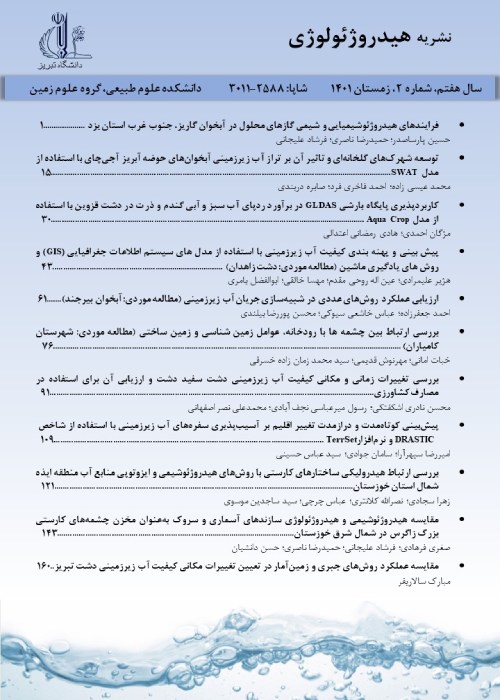Investigating and Modeling the Relationship between Environmental Factors and Ground Water Quality in Tajan Plain- Mazandaran
Author(s):
Article Type:
Research/Original Article (دارای رتبه معتبر)
Abstract:
The aim of this study is to evaluate the effects of different factors on the quality of groundwater and identifying the most important factors and presenting model to predict water quality in Tajan plain. Tajan plain with an area of 631 Km2 is located in the east of Mazandaran provice. The qualitative data related to a 10-year period in 65 drinking water wells were analyzed as basic data in the study area. In order to determine the Ground Water Quality Index (GWQI), six quality parameters; Sulfate, Iron, Nitrate, EC, Calcium, TDS and Chloride were selected via Analytical Hierarchy Process (AHP). Seven factors were analyzed as the variables influencing the quality of groundwater contain population, ground water table, discharge ratio, transmissivity, and distance to outlet, distance to city and distance to fault. The relation between independent and dependent variables was analyzed through Pearson correlation and modeled via multiple regressions. The results showed that the most important factor degrading the quality of ground water in the area is population density upstream the aquifer, such that within urban areas and populated rural areas the water quality is weaker than the other parts of the plain. Presented regression models were validated by four assumptions. Also the zoning map of groundwater quality based on actual data was compared with the maps related to the data extracted from the models. It was concluded that models had enough reliability and ability for prediction. Zoning maps were showed that only 14% of the area has medium and low water quality class but more than 50% of wells had been drilled in this area.
The relation between independent and dependent variables was analyzed through Pearson correlation and modeled via multiple regression. The results showed that the most important factor compromising the quality of ground water in the area is population density upstream the aquifer, such that within urban areas and populated rural areas the water quality is weaker than the other parts of the plain. Another important factor was transmissivity of aquifer's organization means that wherever transmissivity was higher, groundwater quality showed lower. Since the groundwater table is high in Tajan aquifer and it is likely those contaminants entered into the aquifer from the surface therefore in order to drilling the drinking wells the transmissivity and population should be considered. Finally, regression models were validated by four tests, also the zoning map of groundwater quality based on actual data was compared with the maps related to the data extracted from the models, it was concluded that models have enough reliability and ability to prediction.
The relation between independent and dependent variables was analyzed through Pearson correlation and modeled via multiple regression. The results showed that the most important factor compromising the quality of ground water in the area is population density upstream the aquifer, such that within urban areas and populated rural areas the water quality is weaker than the other parts of the plain. Another important factor was transmissivity of aquifer's organization means that wherever transmissivity was higher, groundwater quality showed lower. Since the groundwater table is high in Tajan aquifer and it is likely those contaminants entered into the aquifer from the surface therefore in order to drilling the drinking wells the transmissivity and population should be considered. Finally, regression models were validated by four tests, also the zoning map of groundwater quality based on actual data was compared with the maps related to the data extracted from the models, it was concluded that models have enough reliability and ability to prediction.
Keywords:
Language:
Persian
Published:
Journal of Hydrogeology, Volume:2 Issue: 2, 2018
Pages:
67 to 83
magiran.com/p1832966
دانلود و مطالعه متن این مقاله با یکی از روشهای زیر امکان پذیر است:
اشتراک شخصی
با عضویت و پرداخت آنلاین حق اشتراک یکساله به مبلغ 1,390,000ريال میتوانید 70 عنوان مطلب دانلود کنید!
اشتراک سازمانی
به کتابخانه دانشگاه یا محل کار خود پیشنهاد کنید تا اشتراک سازمانی این پایگاه را برای دسترسی نامحدود همه کاربران به متن مطالب تهیه نمایند!
توجه!
- حق عضویت دریافتی صرف حمایت از نشریات عضو و نگهداری، تکمیل و توسعه مگیران میشود.
- پرداخت حق اشتراک و دانلود مقالات اجازه بازنشر آن در سایر رسانههای چاپی و دیجیتال را به کاربر نمیدهد.
In order to view content subscription is required
Personal subscription
Subscribe magiran.com for 70 € euros via PayPal and download 70 articles during a year.
Organization subscription
Please contact us to subscribe your university or library for unlimited access!


